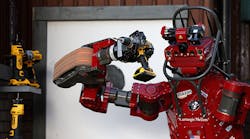POMONA, Calif. — A South Korean team carried home the $2 million top prize Saturday after their robot triumphed in a disaster-response challenge inspired by the 2011 Fukushima nuclear meltdown in Japan.
Team KAIST and its DRC-Hubo robot took the honor ahead of Team IHMC Robotics and Tartan Rescue, both from the United States, at the DARPA Robotics Challenge (DRC) after a two-day competition in California.
The runners-up win $1 million and $500,000 respectively, in a field of more than 20 competitors.
But it is about more than just the money, with the teams also winning the kudos of triumphing after a three-year robotics contest organized by the Defense Advanced Research Projects Agency (DARPA), which commissions advanced research for the U.S. Defense Department.
Over the two days, each robot had two chances to compete on an obstacle course comprising eight tasks, including driving, going through a door, opening a valve, punching through a wall and dealing with rubble and stairs.
The challenges facing them in Pomona, just east of Los Angeles, were designed specifically with Fukushima in mind and were meant to simulate conditions similar to the disaster at the nuclear plant.
In all, 24 mostly human-shaped bots and their teams — 12 from the United States, five from Japan, three from South Korea, two from Germany and one each from Italy and Hong Kong — won through to the finals.
But it was Team KAIST's latest version of its HUBO — "HUmanoid roBOt" — that emerged victorious, topping its competitors from the United States for the $2 million paycheck.
All three scored eight points but HUBO was six minutes ahead of Running Man (Atlas) from IHMC Robotics and more than 10 minutes quicker than Tartan Rescue's CHIMP.
HUBO has been developed since 2002 and weighs about 175 pounds, while standing just under 6 feet tall.
The team, from the South Korean city of Daejeon, says the robot's "uniqueness" is that it can transform from a standing position to a kneeling one designed for wheeled and fast motion.
Not all competitors were so successful, with several malfunctioning or taking a clattering tumble.
Copyright Agence France-Presse, 2015



